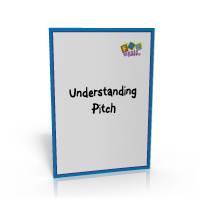Understanding Pitch
Essential knowledge of music notation for learning to play any instrument
Welcome to the second of our articles on beginning music theory concepts.
In this article we hope to address some of the difficulties that students have mastering the area of pitch notation.
Music has many different aspects to it, and pitch is only one of those aspects. However, because musicians need to be able to know and instantly recognize a notes pitch as well as many other aspects of it immediately, it can be a challenge to really understand this well.
Once again, before you start I’d like to re-iterate the importance of DOING the worksheets. Don’t just read through this article and leave it at that. You won’t learn a thing by doing that: you really need to DO the exercises to really internalize it. Music theory is not a subject where you can simply learn it once and its learned forever. Its a bit like learning to read when you were at school… you were given worksheet after worksheet, and test after test until you mastered it. No-one ever learned to read ‘war and peace’ in one session, and music is the same.
Topic #1: Notes in the Treble Clef
We learned previously that the notes were placed on the lines and spaces of the music staff, and the clefs determine exactly what line represents what note. If you’re unclear on any of that feel free to revist the first article on music fundamentals.
One old-fashioned way to remember the names of the notes, i.e. where each note is placed is with a Ryhme like this for the lines and spaces
e.g. for the lines:
And for the spaces, the word ‘FACE’
However, a more reliable way is simply to count up the lines and spaces from the bottom. The first note, on its own line under the staff is middle ‘C’, and you can count up as follows:
This method takes longer to master, but ultimately will work better, particularly if you are learning to play an instrument. The best way to learn this is consistent practice through playing your instrument, and learning a small amount of notes at a time.
So, download and print this worksheet, and make sure you can do it before you go any further:
Worksheet #4 – Notes in the treble clef
Topic #2: Notes in the Bass Clef
One of the confusing factors facing musicians, particularly those wanting to play piano – is the fact that the notes are all different in the Bass Clef.
The lines and spaces are different, and the reasons why will become clear eventually to you.
You can if you wish follow the old fashioned ‘Rhymes’ method for the lines and spaces, but you have to remember a different rhyme:
for the lines:
for the spaces:
Or, a better approach is simply to count downwards or upwards from the note ‘C’
Downwards from ‘middle C’
Upwards from ‘Low C’
You can remember the location of this note by remembering ‘C in the bass goes in the space below the two dots’
Worksheet #5 – Notes in the bass clef
Topic #3: The Grand Staff
Music for the piano or other keyboard instruments is written on two staves, which are joined together on the left by a brace. This indicates that the two staffs are played by one person.
but it is the same note in either case.
Complete the following worksheet, which will help you to understand the relationship of the two clefs, and how the notes work.
Worksheet #6 – Notes on the grand staff
Topic #4: Leger Lines
When a note is above or below the five lines of the staff, small lines called leger lines can be used. The number of them is virtually limitless, but 3-4 is generally the maximum that is needed for most notes. It is quite rare to have notes written above or below that range.
Leger line notes for the treble:
Leger line notes for the bass:
Worksheet #7 – Leger Line Notes
Wow! Four worksheets today! But hopefully that gave you some insight into how the pitch of music notes are identified in music.
When you’ve completed those four worksheets, download this answered version to check your answers.













